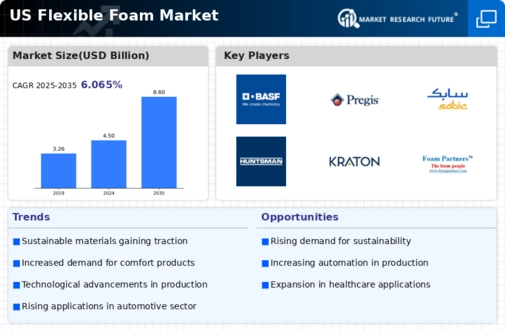The flexible foam market is characterized by a dynamic competitive landscape, driven by innovation, sustainability, and strategic partnerships. Key players such as BASF SE (DE), Huntsman Corporation (US), and Dow Inc. (US) are actively shaping the market through their distinct operational focuses. BASF SE (DE) emphasizes innovation in product development, particularly in eco-friendly foam solutions, while Huntsman Corporation (US) is concentrating on expanding its manufacturing capabilities to meet rising demand in various sectors, including automotive and construction. Dow Inc. (US) is leveraging digital transformation to enhance its supply chain efficiency, which collectively influences the competitive environment by fostering a culture of continuous improvement and responsiveness to market needs.
The market structure appears moderately fragmented, with several players vying for market share. Key business tactics such as localizing manufacturing and optimizing supply chains are prevalent among these companies. This fragmentation allows for a diverse range of products and services, catering to specific customer needs while also intensifying competition. The collective influence of these major players is significant, as they not only drive innovation but also set industry standards that smaller companies often follow.
In November 2025, Huntsman Corporation (US) announced the opening of a new manufacturing facility in Texas, aimed at increasing production capacity for flexible foam products. This strategic move is likely to enhance their market presence and enable them to better serve the growing demand in the southern US region. The facility is expected to incorporate advanced manufacturing technologies, which may further streamline operations and reduce costs, thereby positioning Huntsman favorably against competitors.
In October 2025, Dow Inc. (US) launched a new line of bio-based flexible foam products, reflecting a commitment to sustainability and innovation. This initiative not only aligns with global trends towards environmentally friendly materials but also positions Dow as a leader in the sustainable foam segment. The introduction of these products could potentially attract a new customer base that prioritizes eco-conscious purchasing decisions, thereby enhancing Dow's competitive edge.
In September 2025, BASF SE (DE) entered into a strategic partnership with a leading automotive manufacturer to develop customized foam solutions for electric vehicles. This collaboration underscores BASF's focus on innovation and its ability to adapt to emerging market trends. By aligning with a key player in the automotive sector, BASF is likely to strengthen its market position and drive growth in a rapidly evolving industry.
As of December 2025, current competitive trends indicate a strong emphasis on digitalization, sustainability, and the integration of AI technologies within the flexible foam market. Strategic alliances are increasingly shaping the landscape, allowing companies to pool resources and expertise to enhance product offerings. The shift from price-based competition to a focus on innovation, technology, and supply chain reliability is evident, suggesting that future competitive differentiation will hinge on these factors. Companies that can effectively leverage these trends are likely to emerge as leaders in the market.



















Leave a Comment